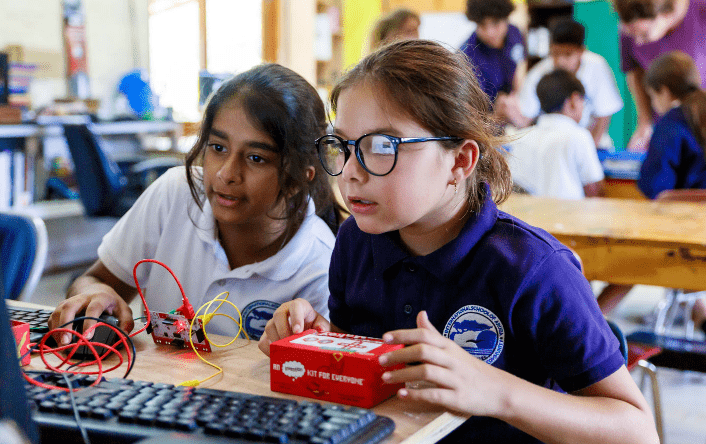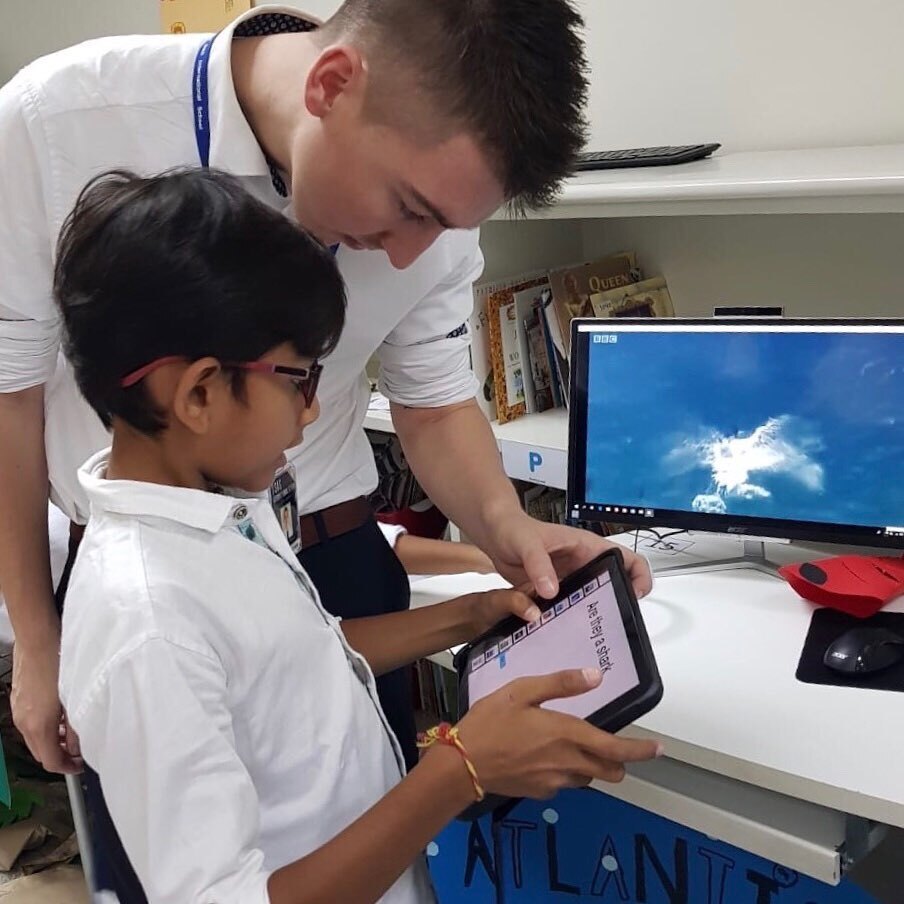To School Tech Directors: How Has the Pandemic Changed How You Operate?
Originally Published in the 2021 School Supply Supplement

Throughout the pandemic, schools needed to adapt quickly to the challenges of providing safe learning environments. With the subsequent rise of virtual and hybrid learning models, schools turned greater attention to new technology needs and new ways of thinking about technology’s role in education.
In light of this, ISS Chief Innovation Officer John Burns posed this question to international school technology directors around the world: How has the pandemic changed your technology planning, staffing, replacement cycles, or the way you operate to support your community? The following reflections share insight into how schools adapted, plus what shifts may still be ahead.
“SIS was in a fortunate position in that its most important application systems had already been moved to web-based systems
These systems were either hosted in the cloud or hosted onsite but made accessible via the Internet; this simplified our issues significantly.
The most difficult problem was then managing Internet bandwidth. Due to both students and teachers being in Shenzhen and outside of Shenzhen, our Internet line would get overloaded if too many devices were livestreaming at the same time. To deal with this, we set up dedicated iPads for livestreaming classes so that individual student and staff devices would not all have to be streaming video simultaneously. Placement of such dedicated devices in order to capture the entire classroom
then became the main issue, as well as management of the devices. Monitoring our network to ensure that we were not overloading it was a constant effort.”
Robert Park, IT Manager,
Shekou International School
“The pandemic has redefined Parent-Teacher conferences.
It’s an experience many prefer as it’s given flexibility especially for working parents to be part of their children’s learning journey, I suspect even when the pandemic is over, virtual conferences will continue.”
Brian Lockwood, EdTech Director,
Copenhagen International School
“The global pandemic has codified the need for educational technologists and school leaders to examine those mental models…
….that are keeping them from evolving the teaching practices needed to meet the needs of their students and teachers.””
Garland H. Green Jr., Director of IT,
The International School of Brussels
“The pandemic has meant an increased emphasis on contingency planning and building in extra redundancies.
Constantly shifting government regulations
and guidelines have meant that we have had to prepare for and actively support multiple learning modalities, always ready to pivot to support our communities in person, online, and in many different formats between the two. This has meant increased costs, increased inventories of hardware and software platforms at the ready, and increased levels of training around the use of educational technology. But it has also meant that our organization is better equipped to engage our students in active learning and support our educators in leveraging technology regardless of their personal circumstance.”
Brian Farrell, Director of Technology,
York House School

“”We were a long way down the road of having a robust digital learning environment that easily supported that old adage of anytime anywhere learning
In saying that our teaching staff were now in a position where they had nowhere to
hide when it came to any hesitations to embracing digital tools. We have struck while the iron is hot and pushed our staff further and recognized their remarkable capacity to grow and develop in their teaching. Recorded online lessons moved to recording more classes at school and reflecting as a professional, identifying students that were falling behind or excelling. This created a curiosity in our staff that has led to action research project and informal inquiry into our practice.
- Our data was helping staff realize the level of teacher talk which has led to discussion around appropriate time for explicit teaching, etc.
- From a tech perspective, we have also pushed our staff to a new platform moving from minority Dell to Mac. They have embraced this, seeing this as an opportunity to grow staff instead of retreat and worry about things we can’t control.
- Staffing in the IT team moved to see our e-coach type role for administrative staff more defined and necessary.
- Community-wise, our area has seen an influx of start-up culture demographic. They have bailed on
places like the US and set up remote offices here on the coast. This is creating an interesting culture shift. - Our parents have embraced blended online, flexibility etc. In fact, many of them expect it. School does not
have the monopoly on students’ time anymore. - We’re beginning to build our new online community. The pandemic has made us rethink what a school online portal/community should be. Some great planning has gone into this, with some brilliant ideas being developed across our community.
Brett Moller, Director of Digital Services, St. Andrew’s Anglican College
“While the pandemic has not seriously impacted technology planning, staffing, platforms, services and other aspects of our operations…
….the pandemic has most definitely validated humankind’s capacity and ability to adapt and respond to rapid change when “shoved into a corner.” Through our collective insights, willingness to try and effort we have not only increased efficacy and agility, but we have become more accepting to embrace a justin-time, rather than a just-in-case, approach. Consequently, this has led to a heightened
level of awareness for the need to explore
opportunities and possibilities through our
strengths and aspirations to reach a desired
future state.”
Dr. Kulangara Jacob Johnson, Director of Techology & Innovation,
Carol Morgan School
“The role of IT as a foundational support for teaching and learning has never been under greater spotlight than what it has been these past eighteen months.
Oftentimes in the past, when it came to
crunch situations for downsizing, budget
reductions, IT Department was always the
first casualty. If we are to return to “better”
rather than just “normal”, technology planning for people and sustainable infrastructure must go along together.”
Reaz Shaheed, Educational Technology Director
Shattuck-St. Mary’s Forest City International School
“Schools often don’t understand
the requirements required for
technology to operate effectively or
efficiently across the organization,
both operations and education.
It’s my hope schools see the light that a well
thought out and implemented technology
plan — along with best practices and quality such as high availability, integrated solutions, remote access, processes and workflows, cross-training, clean data, standards, and so on — are critical to the school operations or contingency plans, and not an afterthought.
Here we are advocating 21st century
learning, cloud solutions, streaming, and
so much more. Yet our infrastructure is
based on late 20th century solutions that
runs paper alongside the technology it
supposedly replaced.”
Frank Thong, Director of Technology,
Shanghai Community International School
“As a Director of Digital & Innovative Learning, my relationship with COVID-19 has been bittersweet.
Prior to the pandemic, I faced a lot of
obstacles and challenges trying to “convince” teachers the necessity and importance of integrating technology into their teaching and learning. Many teachers lacked the time, motivation or energy to develop and grow in areas of digital learning. It did not take much convincing upon arrival of COVID-19. Our team provided weekly training from basic
application system use, to best practices for
technology integration, to social emotional
strategies, and our faculty embraced all of it
enthusiastically.
There is a new sense of confidence in our
faculty which has allowed for new challenges but a lot of new opportunities for innovation not only for remote/hybrid learning, but also in our face-to-face learning environment. We are able to be more thoughtful about the tools that we are using, considering their uses both remotely and in-person, and as a school we have also broadened our collaboration with other schools to be more open and generous with our ideas and resources.
Like a forest fire, COVID-19 has left much devastation in its pathway, but there have
been many opportunities for new growth
and hope for the future.”
Sandra Chow, Director of Digital & Innovative Learning
Keystone Academy
